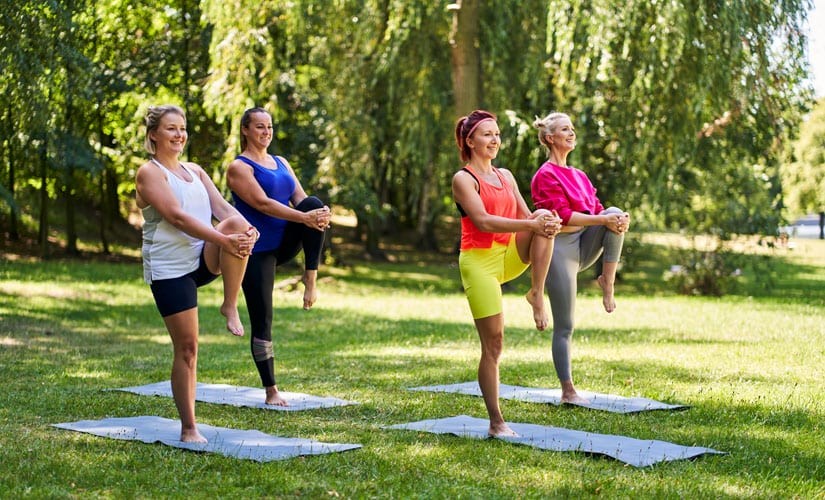
June 21, 2016 marks the second annual International Day of Yoga, as proclaimed by the United Nations. It celebrates the timeless practice of yoga and its ability to contribute to the betterment of the world.
How can yoga improve our world? Many people see it simply as another form of exercise, like running, cycling, or lifting weights. It can definitely be included in the realm of exercise, but yoga has a special quality that sets it apart from other forms of movement. This quality is referred to by researchers as the mind-body connection, which has been discussed by great minds since ancient times.1 Let’s examine it on a practical level.
The popularity of yoga has exploded around the world in the last decade and it’s easy to see why. It is a practice that can be gentle and simple enough for those who are just beginning an exercise program. It can be strong and challenging enough for top athletes. Healing and restorative for those recovering from injury. And fun and calming for kids – yoga is truly for everyone!
The initial physical benefits include increased flexibility and muscle strength, improved posture and balance, improved respiratory function, and increased feelings of relaxation.1 More than that, yoga also positively impacts the brain, nervous system and immune system.1
Many scientific studies now confirm what ancient texts and anecdotal evidence have long claimed. Yoga may help:
- Improve digestion2
- Lower blood pressure3
- Increase bone density4
- Alleviate chronic pain5
- Relieve symptoms of arthritis, carpal tunnel syndrome and plantar fasciitis6
- Alleviate symptoms of depression and anxiety7
- Ease aggressive behavior and impulsivity8
- Assist in preventing and treating addictive behaviors9
- Improve sleep patterns and decrease insomnia10
This gives an idea of the positive contribution that yoga can make to the health of people around the world. However, there are more profound benefits. Yoga actually decreases the effects of stress while increasing feelings of well-being, tranquility, satisfaction and compassion.1 In short, yoga can make you happier and kinder.
Yoga implores you to “check in”, to be present, with what is going on within you. It encourages deep, slow breathing and often requires you to link the movement of your body with the rhythm of your breath. This deep, conscious breathing is relaxing, as it activates the parasympathetic nervous system. This is the part of the involuntary nervous system that slows the heart rate, increases intestinal and glandular activity, and relaxes the sphincter muscles.1
When the body is relaxed and the mind is calm and clear, a person is better able to make sound decisions. They are more likely to choose to spend time in a positive and productive manner, no longer being quite as affected by the anxieties that dwell in the mind—and not as hindered by negative habits. When you cultivate a healthier body and a tranquil mind, you make room for higher thinking, positive habits, and a more giving spirit. When you adopt the principles of a yoga lifestyle, including “ahimsa” or non-violence, your compassion for all living beings is also cultivated.
People around the world are experiencing varying degrees of stress, disease, and dissatisfaction and are in need of the relief that yoga can provide. On International Day of Yoga, we celebrate the power of yoga as described so elegantly by India’s Prime Minister Narendra Modi, who said, “…it embodies unity of mind and body; thought and action; restraint and fulfillment; harmony between man and nature; and a holistic approach to health and well-being. It is not about exercise but to discover the sense of oneness with yourself, the world and the nature.”
On the Inauguration of International Day of Yoga, Secretary General of the United Nations, Ban Ki Moon stated, “Let us see the benefits of this practice in terms of individual well-being as well as our collective efforts to improve public health, promote peaceful relations and usher in a life of dignity for all.”
We hope that you can experience the benefits of yoga in your own life! If you are in need of yoga mats or props, we invite you to stop in to our Wellness Department and find the perfect mat to begin (or continue) your yoga practice.

Wai Lana Yoga products available at Down to Earth stores.
1 Woodyard, Catherine. “Exploring the Therapeutic Effects of Yoga and Its Ability to Increase Quality of Life.” International Journal of Yoga 4.2 (2011): 49–54. PMC. Web. 14 May 2016.
2 Kaswala, Dharmesh et al. “Can Yoga Be Used to Treat Gastroesophageal Reflux Disease?” International Journal of Yoga 6.2 (2013): 131–133. PMC. Web. 14 May 2016.
3 Marshall Hagins, Rebecca States, Terry Selfe, and Kim Innes, “Effectiveness of Yoga for Hypertension: Systematic Review and Meta-Analysis,” Evidence-Based Complementary and Alternative Medicine, vol. 2013, Article ID 649836, 13 pages, 2013. doi:10.1155/2013/649836
4 Lu, Yi-Hsueh PhD; Rosner, Bernard PhD; Chang, Gregory MD, PhD; Fishman, Loren M. MD, B Phil (oxon.). “Twelve-Minute Daily Yoga Regimen Reverses Osteoporotic Bone Loss.” Topics in Geriatric Rehabilitation: April/June 2016 - Volume 32 - Issue 2 - p 81–87. 13 May 2016.
5 Wren, Anava A. et al. “Yoga for Persistent Pain: New Findings and Directions for an Ancient Practice.” Pain 152.3 (2011): 477–480. PMC. Web. 14 May 2016.
6 Wellness Team. Yoga for Heel Pain: Plantar Fasciitis. September 25, 2013.
7 Varambally S, Gangadhar BN. “Current status of yoga in mental health services.” International Review of Psychiatry. 2016 Apr 12:1-3. 14 May 2015.
8 Pike, Georgia. Yoga Lowers Inmates' Aggression and Anxiety. March 1, 2014. Scientific American.
9 Khanna, Surbhi , Greeson Jeffrey M., Complementary Therapies in Medicine, Volume 21, Issue 3, June 2013, Pages 244-252 A narrative review of yoga and mindfulness as complementary therapies for addiction.
10 Mustian, Karen M. et al. “Yoga for the Treatment of Insomnia among Cancer Patients: Evidence, Mechanisms of Action, and Clinical Recommendations.” Oncology & hematology review 10.2 (2014): 164–168. Print.